Hebden Royd Town Council has recently adopted guidelines that it will use when considering wind turbine planning applications.
At the Hebden Royd Town Council meeting on 23 May 2012, the Council approved wind farm guidance from the Strategy and Review Committee meeting on 25 April 2012.
Update Following Calderdale Wind Farm‘s publication of its first scoping report in September 2023, the Full Council recommended the Strategy and Review Committee should review the wind farm guidance. They did at their meeting on Wednesday 18th October 2023 and decided the guidance didn’t need changing.
No wind turbines in Special Protection Area
The guidelines require the Council to refuse applications for wind turbines in the Special Protection Area of moors to the west of Hebden Bridge, and in areas where turbine construction would disturb or destroy peatcover.
Special Protection Areas (SPAs) are internationally important for breeding, feeding, wintering or the migration of rare and vulnerable species of birds within the European Union. They are also Sites of Special Scientific Interest and are protected from activities which would damage the areas’ biodiversity. In Calderdale the South Pennine Moors is a SPA.
There is evidence that wind turbine construction and operation can damage some birds.
Tough requirements for environmental and visual amenity protection in Special Landscape Area
The guidelines will also require wind power developers to provide detailed visual amenity and ecological information in their Environmental Statement for any proposed wind power sites within the Special Landscape Area within and around Hebden Royd.
A Special Landscape Area is an area that local government has categorised as a sensitive landscape, in order to protect it from development or other human influences. Calderdale Council does not permit development within its Special Landscape Area which would adversely affect landscape quality.
The Calderdale Council website has an interactive map that shows the Special Protection Areas and Special Landscape Areas within Calderdale.
The Complete Guidelines
At the Strategy & Review Committee meeting on 25th April 2012, Councillors Sweeney (Chair), Allison, Talbot & Press recommended that the Council adopt the following guidelines:
The under mentioned points should be taken into consideration when wind power applications are being considered:
1. The moors within and surrounding Hebden Royd are designated as a Special Landscape Area, wind power sites must be sensitively placed, and the developer should include detailed visual amenity and ecological information in the Environmental Statement.
2. Moors to the west of Hebden Bridge are designated as Special Protection Area by Natural England because of protected moorland bird species. Wind Power development on these moors would not be supported.
3. Peat is a potential fossil fuel, and CO2 is released when peat is disturbed or drained. Growing peat bog actively removes CO2 from the atmosphere and stores it for thousands of years. The Council will not support wind farm development that destroys or disturbs peat cover.
4. Due to the rainwater holding qualities of the peat moors and possible interference to spring water supplies, a wind power proposal on peat moorland should also be accompanied by hydro-geological information and a Flood Risk Assessment.
5. HRTC expect a well advertised and full public consultation to be carried out before a planning application is made to Calderdale.
6. HRTC Council does not support development of turbines scattered across the uplands and breaking the horizon.
7. HRTC will take special notice of the proximity of a proposed wind farm site to village communities and more isolated homes. Members would need to be assured through the Environmental Statement that no noise nuisance would result from the development.
8. Smaller turbines for the use of individual homes and farms should
be limited to the size and power output commensurate with the local
requirement and to a maximum tower height of 12 metres.9. Wind power sites should be resisted on Urban Commons and open
access land if it is considered that the public access (via the recognised
footpath network) or recreational use could be adversely affected.
What do you think of the guidelines?
Do you agree with them?
Would it be a good idea to include a preference for community-owned wind turbines rather than individual or commercial wind power? Do the guidelines focus too narrowly on environmental issues (vital as these are) and ignore social and economic issues? Such as, who benefits and profits from wind energy – commercial developers, individuals or the community?
If you want to email your Hebden Royd Town Councillor, their profiles and email addresses are here.


I am not local but feel these guidelines are excellent and really should be followed but they could indeed mention that once all this is taken into account Community owned schemes would be not only be supported but would be given precedence.
Pingback: Walshaw Moor Estate owner Richard Bannister looks to swap 5,300 brace of red grouse for 65 x 150-200m wind turbines – Turning Calderdale Green